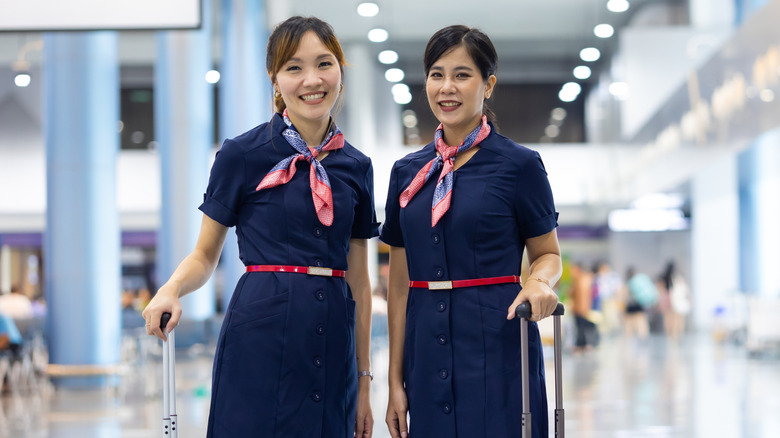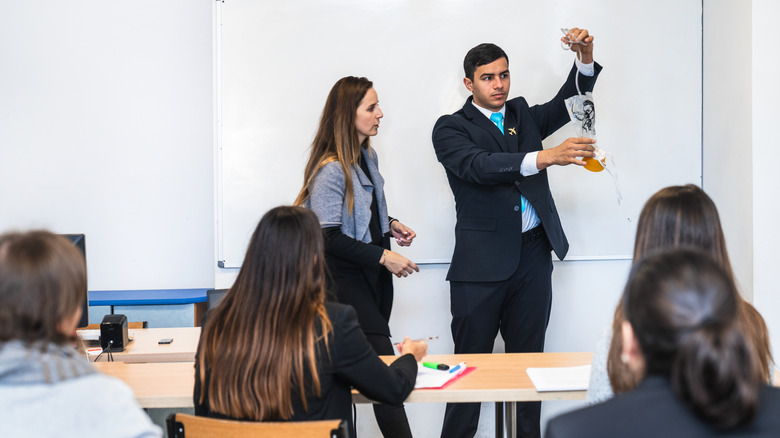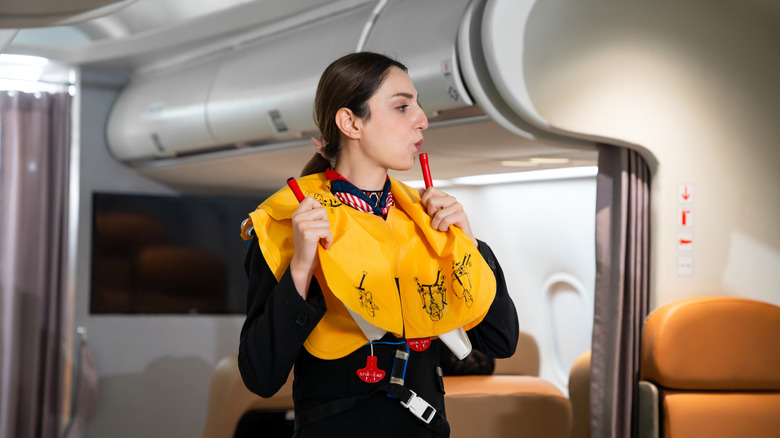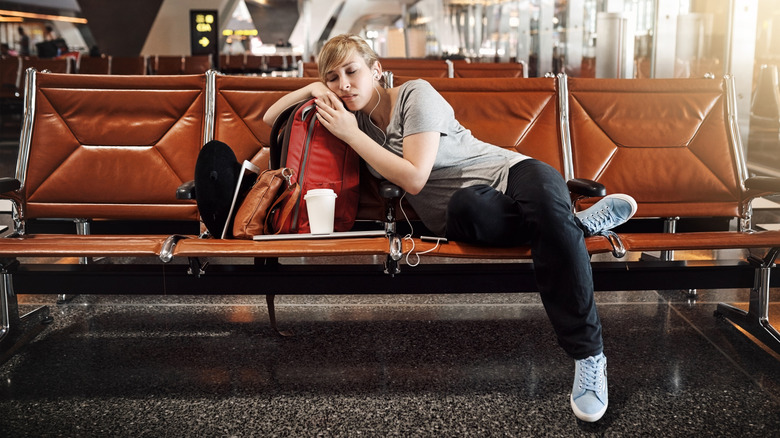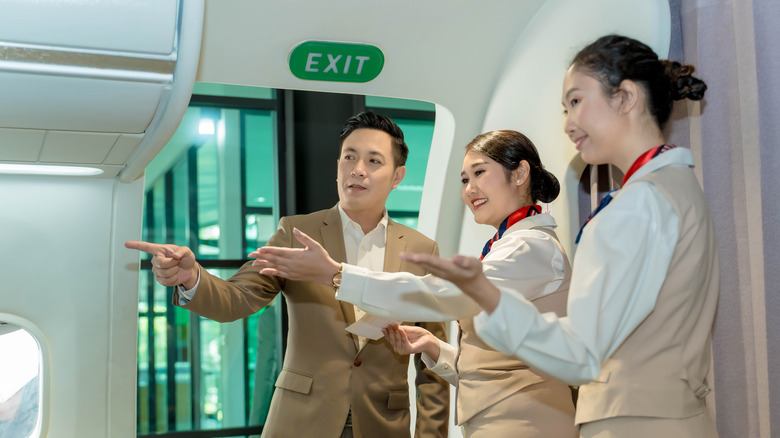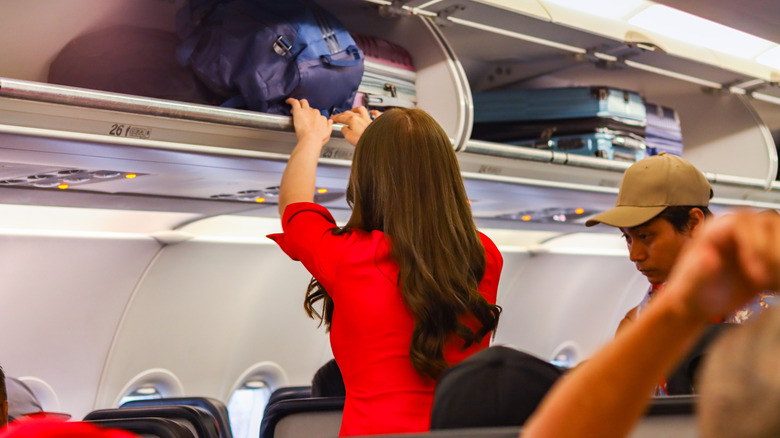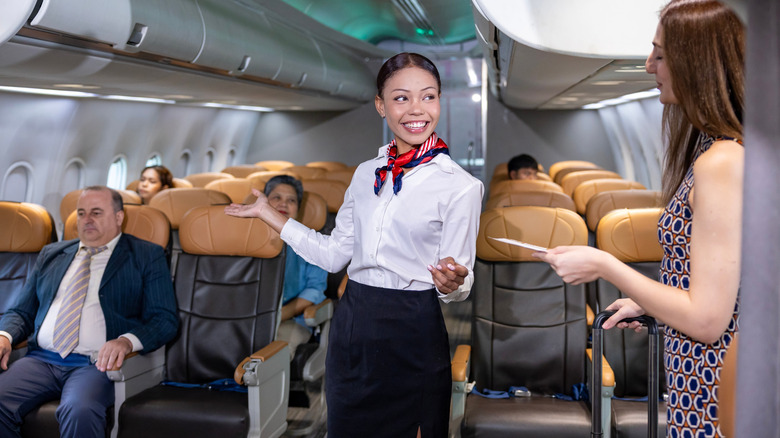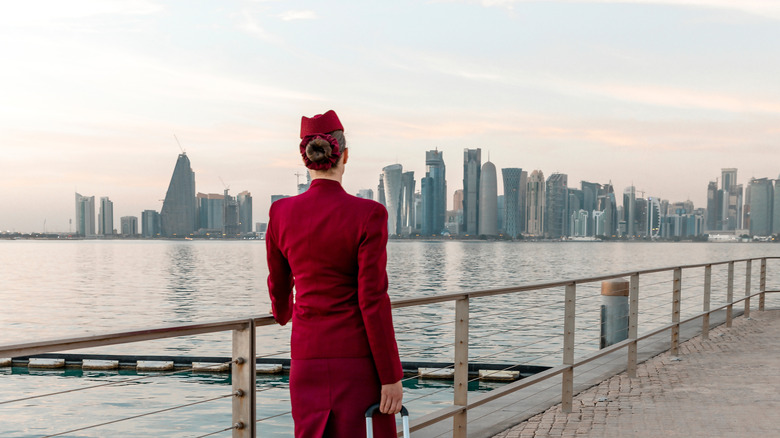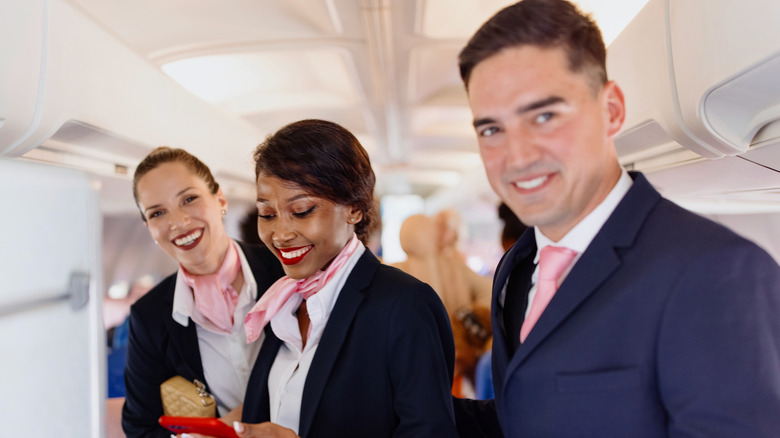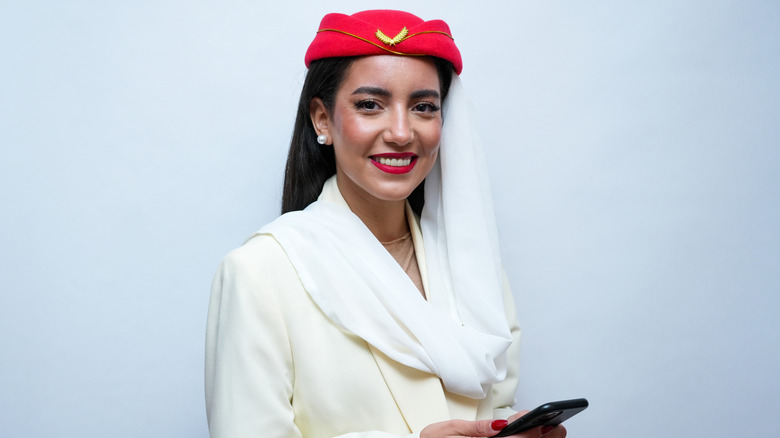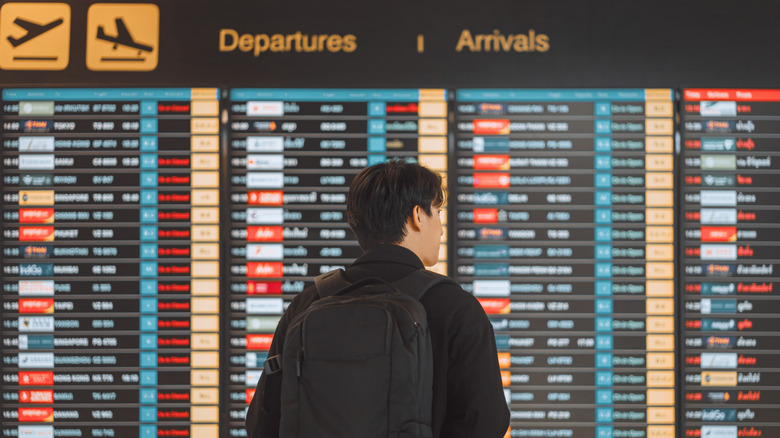The 11 Biggest Misconceptions About Flight Attendants, From Responsibilities To Pay
Ah, the charmed life of a flight attendant. They get to jet off all over the globe, sun themselves in idyllic locations, the kinds of places that have the most beautiful overwater bungalows in the world. They will see countries all over the planet for fun, all in the name of work. What's not to love about the career, especially when you think about the best parts of being a flight attendant? The thing is, though, that while flight attendants do indeed get to travel as part of their job description, the glamor that many of us associate with that benefit isn't the full story.
Flight attendants, also known as cabin crew, work hard, really hard. Their schedules can involve early mornings, late nights, weekends, and emergency shifts to cover colleagues who are sick or unavailable. They don't necessarily get paid a lot, yet they are expected to remain upbeat. While many passengers might think of them as trolley dollies, or waiters in the sky, flight attendants are so much more. Islands spoke exclusively to Johanna (who prefers to go by her first name only), a flight attendant with a decade of experience in the air, and got the lowdown on the reality of life in the not-always friendly skies and the many misconceptions people have of flight attendants.
1. It is easy to become a flight attendant
All you need is the ability to smile and be good with people, and you too can have this job, right? Wrong. "Although hiring needs have changed for airlines over the years, especially during and after the time of COVID-19, it's extremely difficult to become a flight attendant," explains Johanna. "Acceptance rates are as little or lower than 1%, especially for larger legacy airlines like Delta." This means it is harder to get this job than to get accepted into an Ivy League university. For starters, there are unusual rules and requirements for being a flight attendant. These range from prior experience in certain types of work to fluency in a language.
For Johanna, the real meat of the process began during the interview, when she was accompanied by 500 other applicants applying for the same position. Some of the tasks she had to perform during that day included group activities, interviews with HR (both one-on-one and also with a team of HR personnel or other flight attendants), reading scripts, and more. Once an applicant gets past the interview stage, the next step is training, usually in the city where the airline is headquartered. This can last up to six weeks, and requires actual studying as well as hands-on exercises, such as evacuating a cabin or how to handle passengers that are difficult. Pass all these, and the applicant will finally get their wings.
2. Their primary job function
Nobody knows exactly when the term trolley dolly first originated, but there are accounts of it appearing in the Oxford English Dictionary as far back as the 1950s. It was a slang description used mainly by the British and Australians, and its meaning is self-evident. But, even back when it was part of common parlance, it was a misrepresentation of the role of the cabin crew, as Johanna points out. "One of the biggest misconceptions about flight attendants is that our primary job is to serve during inflight service. The primary function of a flight attendant's job is always going to be safety," she clarifies.
Yes, they have to deal with customers who can be demanding and unruly — follow this primer from flight attendants themselves on how to be the best passenger to avoid this — but this is not the main thrust of a flight attendant's job. "We're trained on how to operate the doors and understand the layouts of multiple different aircrafts so we can execute evacuations in under 90 seconds," Johanna explains. Attendants also must undertake training to be able to respond to many types of emergencies. These include such wildly varied scenarios as violent passengers, fires, the proper way to contain an explosive until the plane can land, and medical emergencies like choking and CPR.
3. They are paid during delays
For people that work in an office, a store, a warehouse, a restaurant, and so on, it is pretty obvious when the working day starts. But for a flight attendant, how do they calculate what it is considered the beginning of the work day? Is it when they arrive at the airport or are waiting by the gate? Maybe it is when they are on the plane? None of those is quite accurate, and pay is actually arranged in different layers. "The pay structure for a flight attendant is very complex, but our largest pay rate is only received after everyone is on board and the aircraft door is closed," explains Johanna.
So, if a flight is delayed for any reason — inclement weather, the plane arrives late from its incoming flight, etc. — you, as a passenger, won't be the only person that will be irked by it. "The line we hear the most during long delays from passengers is, 'At least you're getting paid,'" Johanna recounts. "And while this is technically true, it's not in the way most people think." She notes that flight attendants receive much lower pay rates for times that they are on duty but not actually in flight. That even applies to days when they are away from their home base on a layover, even though they are there because of work. "It doesn't amount to nearly as much as our inflight pay rate," she adds.
4. They are paid for boarding and deplaning
As we have mentioned, a flight attendant generally only gets paid their full rate when the plane doors are closed and everyone is onboard. "Boarding an aircraft of hundreds of people is tedious work that involves assisting with bags, briefing safety information, dealing with customer issues, like seat duplications, and ensuring compliance with FAA regulations for take-off," remarks Johanna. Given that, it is fair to assume that they will be paid for all these duties at the full rate, right? After all, they are all part of the job description.
"Unfortunately, industry standard dictates that flight attendants only receive their full pay rate when the airplane door is closed," Johanna confirms. This, at least for many decades, was the normal state of affairs in the airline industry. More recently, airlines have started to re-examine this arrangement. In 2022, Delta began to give boarding pay, which is still less than the full inflight rate. And from April 2025, the Association of Professional Flight Attendants, a union that represents tens of thousands of cabin crew all over the country, was able to secure boarding pay for its members.
5. They should help with your bags
We have all experienced this scenario. Someone is struggling to put their bulky suitcase in the overhead bin, either because it is ridiculously heavy or its dimensions make it difficult to handle. At that point, someone steps in to help, possibly another passenger or a flight attendant. But the cabin crew is not required to help passengers with their bags — if a passenger can't lift or maneuver their own luggage, then they should consider bringing on something lighter and easier to control. "We're often in the aisle to assist with finding a place for your bag during boarding, but it's not our responsibility to lift it into the overhead bin," says Johanna. "Flight attendants can work up to four flight segments per day, and that means hundreds of people with bags during four separate boardings."
Some of these bags are heavy, so heavy that they feel like they are packed with bricks. That's not only dangerous for the passenger who needs to lift it, but also for cabin crew that try to help, and it's one request that flight attendants hate. Imagine having to lift multiple bags at the beginning of each flight. The risk for injury is high, especially since you don't know the contents of each bag, how much it weighs, or the distribution of that weight, all factors that you need to assess before lifting anything. "Many airlines do not cover [leave] if a flight attendant is injured while lifting a passenger bag," explains Johanna. "I will always assist a customer with lifting their bag, but only if we do it together."
6. They all make the same amount of money
Just like in any job, people within the same organization doing similar roles can make markedly different salaries. The same rings true for flight attendants. "Not only does pay vary by airline for flight attendants, it's hierarchical based on seniority, or how many years the flight attendant has been working for that specific airline," Johanna points out. According to the U.S. Bureau of Labor Statistics, the median salary for a flight attendant in 2024 was about $67,000. But that is definitely not what entry level attendants can expect to earn.
Salaries for United Airlines crew, for instance, start at about $29 per hour, and according to ZipRecruiter, an average entry-level flight attendants will often begin with a wage of less than $50,000 per year. "If you have four flight attendants working the same flight, chances are they're all receiving different paychecks for their workday, and the differences can be vast. A new flight attendant can make as low as $25,000 a year while a senior flight attendant can make over six figures a year," Johanna continues.
7. They only fly specific routes
Unlike the same faces you might see on the train, subway, bus, or sidewalk on your morning commute, flight crews aren't mired in a routine. You might assume that a specific crew is assigned to set routes, like some of the longest flights in the world, but this is not the case. "'What route do you fly?' is one of the most common questions I get as a flight attendant, and the truth is, this is impossible to answer because most of the time every day is different," Johanna shares.
Many different factors go into deciding who flies what route and on what date. Speakers of a second language are likely to be assigned to certain sectors where that language is useful, but they will not be exclusively seconded to those flights. As Johanna explains, schedules are awarded by seniority, "meaning flight attendants who have been with the airline the longest get their first pick of available trips." What this means, in reality, is that experienced flight attendants might be able to work the system and fly similar trips from month to month. However, for the vast majority of crew, the schedule that they get is more notable for its variety than its uniformity. What is true is that attendants will only fly on planes that they have trained on, and this will govern where they end up going.
8. Layovers are always glamorous
Another image that many of us might have of flight attendants is that they are usually heading to a glamorous destination, where they lazily lounge by a pool or the sea or live it up on rooftop bars in buzzing cities. This might possibly happen, but it is not a frequent occurrence, as Johanna reveals: "Flight attendants can be scheduled for as little as a one-day trip, or for as long as a four or five-day trip. Sometimes longer during operational disruptions. Some layovers include over 24 hours in a desirable city, but many do not." Some layovers allow cabin crew to have some downtime in their destination to do the kinds of things that we assume they do. But some don't.
"Layovers can be reduced to as low as 10 hours at my airline and this includes the time it takes to get from the airport to the hotel and back again," Johanna explains. "Leaving little time for anything other than sleep." For many flight attendants, layovers are the periods for concentrating on rest and recuperation. They might have flown across multiple time zones, worked throughout the night, and may be headed back home in a day or two. They need to be fully recharged for the return flight, and the only way to do that is to rest and replenish, which means staying in the room and sleeping. Glamorous indeed!
9. They are all single women without children
Way back when commercial aircrafts began to take passengers, the majority of flight attendants, known then as stewards, were actually men. It was in 1930 that the first female was hired, a woman by the name of Ellen Church. Slowly, the industry transformed, and cabin crew started to skew toward a very specific look. They were generally white, female, good looking, and not married, a way to appeal to the passengers who were mostly men.
"While this may have been the original standard for flight attendants, it certainly isn't anymore," asserts Johanna. "Most people I fly with are in relationships or married, and it's certainly not uncommon for them to be parents as well." According to CareerExplorer, the majority of flight attendants in the U.S. are still women, with 86% of them female compared to 14% male. The career assessment website did not specify how it collected these statistics or the amount of data it analyzed. It also states that, based on data from 2019 from the Bureau of Labor Statistics, half of attendants are white, while 1/10 or more are either African American, Latin, or East Asian.
The career site Zippia reached slightly different conclusions, reporting that 21.1% of flight attendants are male. It also found that over half of attendants are white, with Hispanic or Latino, Black or African American, and Asian representation ranging from 7.6% to 15.8%. It reached these percentages by analyzing data from 30 million profiles.
10. They aren't educated
You don't really need an education to be a flight attendant do you? After all, you just need to interact with strangers, reel off a few safety presentations, and serve some food and drinks. Why would you need a degree for that? While it is certainly possible to become a flight attendant without having studied beyond high school, this is not the case for all cabin crew.
"Many flight attendants I know, myself included, have degrees from higher education," notes Johanna. People with a degree are actually in the majority. Data from CareerExplorer shows that 70% of flight attendants have some sort of qualification from an educational institute beyond high school, while the rest have a high-school diploma. "Hospitality, nursing, business, and law are degrees I commonly see among my peers," Johanna says.
Even beyond formal education, flight attendants tend to be more worldly and good with people. They have to be — interacting with all sorts of passengers from all over the planet as part of their daily job constantly requires refreshing their interpersonal skills.
11. They can call ahead to hold a plane for your connection
Flight attendants might work for an airline, but that doesn't mean that they have a secret path into the carrier's inner workings or some special tricks that they can use. Sure, they are more wired into the airline's mainframe than the average passenger, but they can't, as some passengers believe, keep a plane waiting at a gate so that a flier can make the connection. "We absolutely cannot," declares Johanna. "The most we can help you with is to look up your connecting flight to see how far away your gate will be, or if perhaps your connecting flight is also delayed."
As mentioned earlier, attendants' primary function is to ensure safety on the plane. There is a reason they are called flight attendants, because their purview is the flight in which they are working. Beyond that, they have limited ability to impose any control on the situation. Johanna suggests that if a passenger misses their connecting flight, they will have to contact airport operations — either a phone representative or a gate agent in the airport at a help desk — to get rebooked onto another flight.
